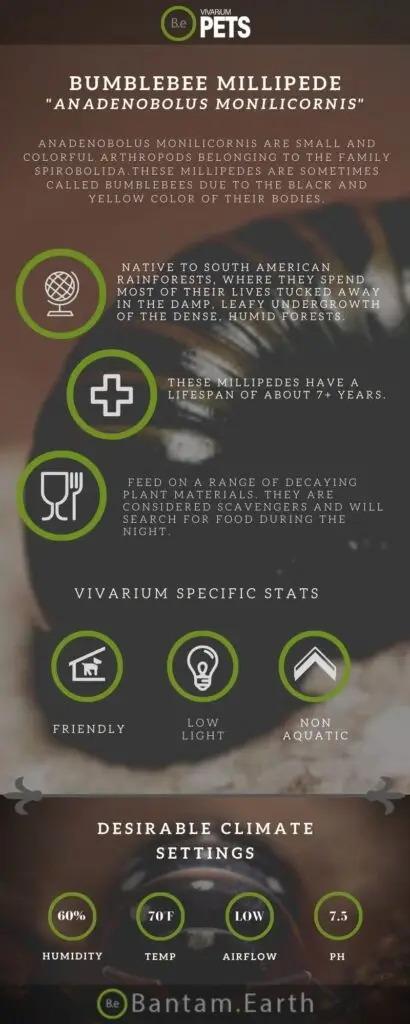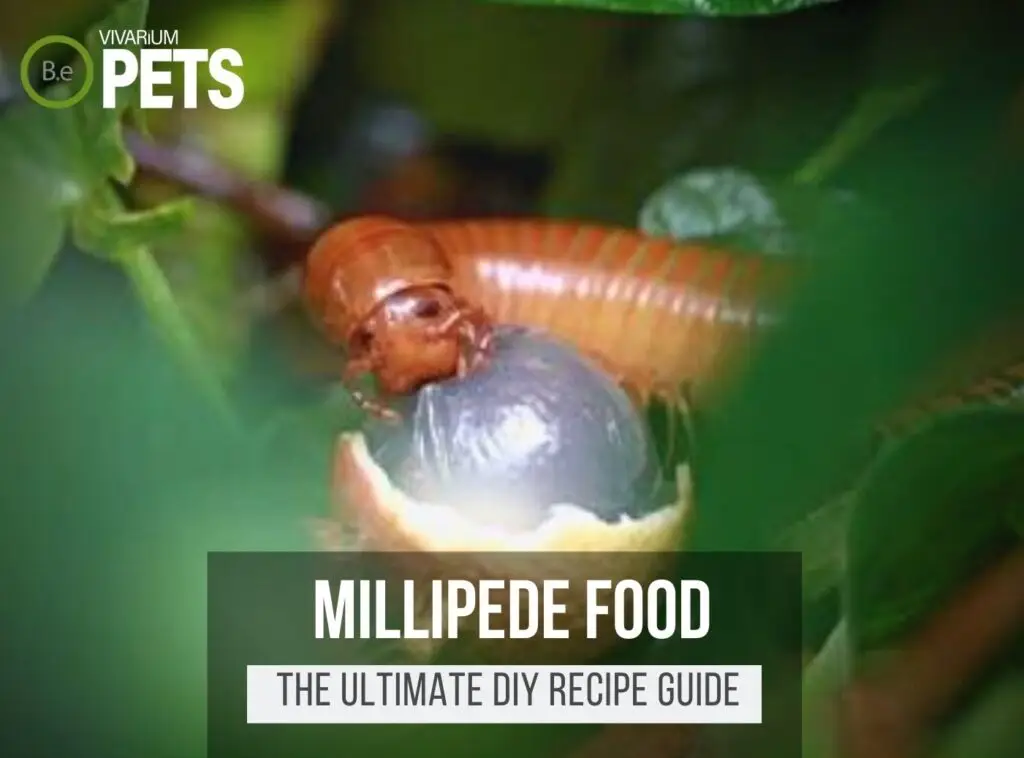Bumblebee Millipedes, aka Anadenobolus monilicornis, has been on my “to-do” list to cover for a while now.
I’ve now finally got around to converting my study notes to blog format and I hope you find these useful!
These small and colorful arthropods are native to America and very easy to come by depending on which state you live in.
In this guide, we’ll cover the basics of caring for this giant millipede, including its substrate and habitat needs, what to feed it, and its temperature and humidity requirements.
We’ll also talk about tank mates, socialization, and breeding, as well as potential health issues and how to prevent them.
Read on to learn more about these charismatic critters!
| Characteristics: | |
|---|---|
| Common Name | Bumblebee Millipede |
| Family Name | Spirostreptidae |
| Scientific Name | Anadenobolus monilicornis |
| Use | Cleaning, Aerating Soil, Pets |
| Temperament | Non-aggressive |
| Lifespan | 7+ Years |
| Diet | Detritivore |
| Adult Size | 10 cm |
| Breeding Type | Egg Layer |
| Care Level | Easy |
| Minimum Tank Size | 10-15 Gallons |
| pH | 7.0-8.4 |
| Hardness | Soft |
| Temperature | 60-75°F |
What Are Bumblebee Millipedes?
Anadenobolus monilicornis are small and colorful arthropods belonging to the family Spirostreptidae.
These millipedes are often called bumblebees due to the black and yellow color of their bodies.
They are a popular choice for pet owners due to their low-maintenance and exotic appearance.
What Do Bumblebee Millipedes Look Like?
Bumblebee Millipedes can reach up to 10cm long and have a striking yellow, black, and brown coloration.
They have smooth, oval-shaped segmented bodies and can have up to 8 legs per segment.
They also have two long antennae and two short ones, which they use to explore and sense their environment.
A pair of forceps-like mandibles are used to grab and cut their food.
The underside of their body has two respiratory openings, or spiracles, that they use to breathe.
Benefits Of Using Bumblebee Millipedes
Anadenobolus monilicornis make great additions to vivariums thanks to their distinct look, peaceful nature, and ease of care.
With their large size and striking banding patterns, they make an eye-catching addition to any enclosure.
The Bumblebee Millipedes are also highly beneficial to tanks as they eat decaying plant matter, clearing out any potentially harmful bacteria and fungus.
They are excellent scavengers and are incredibly efficient at keeping the habitat clean, further enriching the miniature ecosystem.


Bumblebee Millipede Facts
Anadenobolus monilicornis are native to the US and are popular pets due to their colorful and unique appearance.
They feed on dead organic matter in the wild, and in captivity enjoy a diet of fruit, vegetables, and decaying leaves.
Additionally, their nocturnal behavior helps them blend into their surroundings since most of the time they are tucked away in the substrate.
Breeding is possible but challenging and requires a moist and humid environment with consistent temperatures.
Habitat
Bumblebee Millipedes are native to South American rainforests, where they spend most of their lives tucked away in the damp, leafy undergrowth of the dense, humid forests.
They eventually become naturalized in southern parts of the United States and can be commonly found in tropical regions today.
They thrive in areas near water sources and areas protected from excessive sun exposure.
Anadenobolus monilicornis spends most of its life under the leaf litter or logs in the forest.
This habitat provides not just a cool, damp location but also a safe home where predators cannot hunt them easily.
Diet
In their natural habitat, Bumblebee Millipedes feed on a range of decaying plant materials.
They are considered scavengers and will search for food during the night.
As for what plants they prefer to feed on, the answer varies depending on their location.
However, it usually consists of decaying leaf litter, rotten wood, and fruits such as mangos, guava, and banana.
These millipedes also eat fungi, mushrooms, fungi, and bacteria. They don’t care for fresh or healthy foliage, however.
Temperament
Bumblebee Millipedes are generally not aggressive and are fairly timid towards humans and other animals.
These millipedes may curl up into a tight ball when threatened or startled, and may even secrete unpleasant-smelling substances to ward off potential predators.
While many pet owners handle these millipedes, it’s generally not recommended as these arthropods can be quite fragile and easily injured due to their soft exoskeletons.
Anadenobolus monilicornis are not particularly social, preferring to live and feed alone.
However, when kept in small groups, they may be able to coexist peacefully.
It’s important to note that Bumblebee Millipedes housed together should always have a safe place to hide in case of any possible squabbles.
It’s also a good idea to give them plenty of space to prevent any issues due to overcrowding.
Lifespan
Anadenobolus monilicornis have an average lifespan of 3-5 years, although some can live up to 7 years.
These colorful arthropods typically begin their life as eggs, laid by the female in a burrow or protected area.
The eggs hatch into larvae, which look similar to adults but are smaller in size.
They shed and molt their exoskeletons several times, each time growing larger and closer in size to adults.
The process from egg to adult takes 6 to 12 months depending on environmental conditions and food availability.
Once adults, Bumblebee Millipedes typically spend their time foraging for food and searching for mates.
Breeding
Bumblebee Millipedes mate in a unique way.
When they mate, they typically form a wheel-like wheel structure in which they line up in a circle, and a male and a female connector to reproduce.
They will typically remain in this wheel-like structure for several minutes while they exchange sperm.
Once mating is complete, the female will lay eggs in moist soil.
The eggs will typically hatch in two to three weeks and the young millipedes will look much like adults, just smaller in size.
Where To Find Bumblebee Millipedes
Finding Bumblebee Millipedes in the wild can be challenging, as these arthropods are rarely seen outside their native range.
However, it is possible to find Anadenobolus monilicornis for sale from licensed exotic pet dealers or online pet websites.
When searching for these millipedes, it’s important to look for an individual with a healthy, glossy exoskeleton and no visible wounds.
Past that, make sure to find a pet store or breeder that takes proper care of their animals and provides a healthy and clean environment.
Bumblebee Millipede Care
Caring for Bumblebee Millipedes requires providing them with few necessities.
A terrarium substrate and habitat that meets their specific needs, feeding them a variety of nutritious food and maintaining appropriate temperature and humidity levels.
Selecting suitable tankmates, and monitoring them for potential health issues is just as important.
With the right care, Anadenobolus monilicornis can be a wonderful addition to many vivarium types.
Tank Requirements
The ideal tank for Bumblebee Millipedes should provide both dry and damp areas, meaning a mixture between a wet and dry terrarium or paludarium.
A humid substrate is also ideal, meaning an appropriate ratio between coco fiber, peat moss, sand, and leaf litter should be used.
A pH of around 7.0 and representing an average to slightly hard hardness is ideal, as they often live near streams and other water sources in nature.
The ideal temperature range should provide a day/night cycle between 70-80°F with some warmer spots reaching up to 85°F during the day.
The terrarium lighting should be dim or indirect with no direct UV exposure.
In short, a moist and humid habitat is best for the Anadenobolus monilicornis.
What Do Bumblebee Millipedes Eat?
Feeding Anadenobolus monilicornis is simple, although they can be lightly picky when it comes to what they will consume.
To ensure that your Bumblebee Millipede is receiving proper nutrition, you should feed them a variety of different foods.
Here are some items that you can feed your millipedes:
- Fruits – apples, pears, oranges, bananas, peaches, papaya, etc.
- Vegetables – spinach, romaine lettuce, collard greens, Brussels sprouts, broccoli, etc.
- Leafy greens – dandelion greens, clover, culinary herbs, etc.
- Seeds – sunflower seeds, hemp seeds, chia seeds, etc.
- Insects – waxworms, mealworms, crickets, dubia roaches, etc.
- Dog, cat, and reptile food – look for high-quality formulas to supplement their diet.
If you’re more of an avid hobbyist like myself, be sure to check out my ultimate DIY Millipede food guide. I give a more in-depth explanation of the best foods and my favorite recipe.
Best Tankmates For Bumblebee Millipedes
Bumblebee Millipedes are strong and low-maintenance animals that can live comfortably with a variety of tankmates, provided that the tankmates are not overly active or aggressive.
Good tankmates for Anadenobolus monilicornis should have similar needs when it comes to temperature, humidity, and substrate.
Some of the best tankmates for Bumblebee Millipedes include snails, isopods, and springtails.
All of these animals offer similar beneficial qualities to Anadenobolus monilicornis, such as a safe and secure environment, protection from predators, and the opportunity for socialization.
Conclusion
Caring for the Bumblebee Millipede is not as daunting as it may seem!
With a proper setup, the right substrate, nutrition, and tank mates, these incredible creatures can make great additions to your home.
As with most exotic millipede pets, understanding the necessary habitat and diet requirements along with potential health issues is key for providing your millipedes with a happy and healthy home.
Now that you have a better idea of what to expect, you can confidently and successfully care for an Anadenobolus monilicornis of your own!
Frequently Asked Questions
Bumble bee millipedes are not poisonous to humans or other animals.
However, it is still recommended to avoid handling them unnecessarily to prevent skin irritation or allergic reactions from their defensive secretions.
Bumblebee millipedes can be handled when careful. However, they should not be held unnecessarily as they can cause skin irritation or allergic reactions in some people.
It is best to observe them from a safe distance, and only handle them if necessary for their care or removal from an area.
Bumblebee millipedes can grow up to about 4 inches (10 cm) in length.
However, the size of individual millipedes can vary depending on factors such as their age, diet, and environmental conditions.
Bumblebee millipedes are native to Central and South America but have been introduced to other parts of the world, including parts of the United States.
They are not considered to be invasive or a major threat to the environment.
In general, millipedes have relatively long lifespans for arthropods, with some species living up to 7 years or more in the wild.
The lifespan of a bumblebee millipede can vary depending on factors such as age, diet, and environmental conditions.
Bumblebee millipedes are detritivores, which means they primarily feed on decaying plant matter such as fallen leaves and other organic debris found on the forest floor.
To take care of a bumblebee millipede, you should provide them with a substrate of moist peat moss or coco fiber and keep their enclosure clean and humid.
They also require a source of decaying plant matter, such as fallen leaves or rotting wood, for food.


